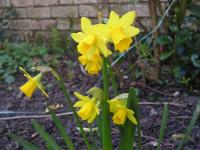Blind as a Daffodil
 Daffodils without flowers are termed 'blind'
Daffodils without flowers are termed 'blind'Simple steps to make sure your Daffodils bloom year after year.
One of the most frequently asked questions in early Spring in gardens across the country is: Why donít my daffodils have any flowers?
When a daffodil only produces foliage and no flowers it is said to be Ďblindí.
Daffodils often produce a good display of flowers in the first year after planting, but displays in subsequent years are often poor until no flowers are produced at all.
Quality Bulbs
The first remedy to prevent daffodil blindness is to purchase good quality stock from a reputable supplier.
The bulbs should be firm, plump and free of any visible mould or disease.
Planting Considerations
Planting is the most important step to get right though to produce a good display of flowers year after year.
Depth of Bulbs
The most common problem is simply that gardeners do not plant their daffodil bulbs deeply enough. The top 10cm of soil in any garden is usually always drier than the next 10cm below it. Before planting daffodil bulbs measure their physical depth and use this figure when digging the planting hole.
A daffodil that has a physical depth of 6cm should have at least 12cm of soil on top of it, therefore you need to dig a hole that is at least 18cm deep. With any bulb always make sure that it has at least twice its own depth of soil on top of it.
So, the bigger the bulb (in terms of depth) the deeper you plant it.
Itís not really the depth that is so important, itís the moisture that is available at different depths of soil. Remember that water is the main transportation system by which nutrients move up through the roots. You can have a well nourished soil, but if it is dry the bulb cannot take up the food and nutrients.
Distance Between Bulbs
The next important step is the distance between the bulbs in the planting hole. A distance of 2-3 times the width of the bulb between each bulb is important otherwise they quickly crowd each other out and compete fiercely for moisture and nutrients.
If you donít want to dig up a congested clump and correctly re-space the daffodil bulbs you can alternatively just feed them with a balance liquid feed once per fortnight when the normal flowering period has finished until the foliage completely dies down.
You often see daffodil foliage neatly tied up in a bunch after flowering. In my opinion this is not a good thing to do because it reduces the available surface area of foliage that is exposed to the sun therefore reducing the rate of photosynthesis (the process by which plants produce food using sunlight).
So for a trouble free crop of daffodils full of flowers remember the 4 golden rules:
- Good quality stock
- Correct depth when planting
- Correct spacing when planting
- Leave foliage after flowering until it is brown
Filed under General.
